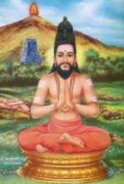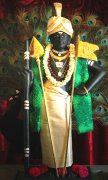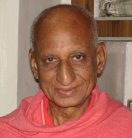

THE ESOTERIC
KANDAR ANUBHUTI
OR
THE SECRET TEACHING ON
GOD-EXPERIENCE
(A Treatise on Adwaitic Realization)
OF
SAINT ARUNAGIRINATHAR

 |  THE ESOTERIC KANDAR ANUBHUTI OR THE SECRET TEACHING ON GOD-EXPERIENCE (A Treatise on Adwaitic Realization) OF SAINT ARUNAGIRINATHAR |  |
 | by N.V. Karthikeyan |  |
| verses list of verses intro 1 2 3 4 5 6 7 8 9 .. 12 PDF version |
The Avatara or Incarnation of Lord Skanda The Avatara or Incarnation of Lord Skanda according to the Tamil scripture known as the "Kanda Puraanam" is as follows. In the fights that go on perpetually between the Devas (gods) and Asuras (demons), the Devas defeated the Asuras repeatedly. To avenge for their defeat, the demoness Surasa got through the sage Kashyapa, by a deceitful marriage with him, three sons, viz., Soorapadma, Simhamukha, and Taaraka. She asked them to do severe Tapas or austerity propitiating Lord Siva. Accordingly they did and obtained from Him many boons by which they became invincible. They started giving trouble to the gods, invaded and captured Devaloka (Svarga) and subjected the Devas to great humiliation. Soorapadma extracted from them even menial service, and as days passed by, his atrocities also increased. Unable to bear the torture any more, the Devas, under the leadership of Indra and headed by Brahma and Vishnu, approached Lord Siva in Mount Kailasa for help. They surrendered themselves to the Lord and cried out to Him for immediate protection. Moved by compassion, Lord Siva assured them His help. As, however, the Lord again was absorbed in meditation, the Devas entreated Kamadeva (cupid) to awaken the Lord from his Samadhi. Though unwilling, due to fear of the Lord, yet compelled by the Devas, Kama disturbed the Lord by his flowery arrows. Thus, disturbed in meditation, the Tejas or Light that flashed forth from His third eye burnt Kamadeva (Cupid). The Devas at once fell at the Lord's feet and prayed for help without any further delay. As the Asura had obtained boons from Lord Siva, He could not kill him in His form as Siva. The Lord, therefore, assumed His original form of six faces and from the third eye of each face a Light (Tejas) emanated which filled all space. The Devas, bewildered at this unexpected happening, trembled in fear, but the Lord assured them safety and withdrew the Light into His own hands. He passed on that Light to Vayu (Wind-God) and Agni (Fire-God) commanding them to carry it to Ganga. But when they hesitated to receive it because of its mighty power, Lord Siva granted special power to them. Vayu, with the strength granted by the Lord, carried it somehow, with great difficulty, for some distance, and unable to carry it any further, gave it to Agni, who hurried and threw it into Ganga. Ganga was also unable to bear the power of the Light and she carried it on to a small pond surrounded by Sara-shrubs called Saravanappoigai. Alas! Nothing happened to the pond, but a wonder took place. Immediately on reaching the pond, the Light assumed the form of six-beautiful babies, with Divine splendor, lying on six lotuses. Vishnu, Brahma, and all the gods assembled there to witness this Avatara or Incarnation of Lord Subrahmanya. They asked the six Kirtika Devis to suckle the six babies and feed them, which they did. In the meantime, Lord Siva and Parvati arrived there, and when Parvati took the babies, they joined together into a single body with six faces and twelve hands. This is Lord Shanmukha (Lord with six-faces) whose nature it is to bless those who take refuge in Him, as that is the purpose of His Avatara. He is called Skanda ("one who leaped out," referring evidently to the way of His emanation from Siva's third eyes); Skanda also means "the joined One" as the six-babies joined and assumed a single form. He is called Kartikeya, as He was nursed by the Kirtika Devis (3rd constellation of the 27 stars); He is called Saravanabhava, as He was born in the pond of Sara-plant (Saravanappoigai). In the Tamil language and literature He is more popularly known as Murugan, the Lord of Eternal Youth and beauty. He is called Subrahmanya, as He is Brahman, the Absolute, Himself. The Lord has many other names, too. Since he was born of the third eye (Eye of Wisdom) of Lord Siva, He stands for supreme Divine Wisdom and is an incarnation of pure Consciousness (Siva). A remembrance of these facts will help us much in our study of the work of Kandar Anubhuti. Kacchiyappa Sivachariar (about the 9th century A.D.) who was ordered by Lord Shanmukha to compose the work 'Kanda Puraanam' in Tamil, by giving him the first line for his work, precisely and beautifully portrays the Lord's Avatara thus, in two verses: "That Consciousness-Mass (Light or Tejas) (சோதிப் பிழம்பு) which is called the Supreme Brahman, which is formless, with form, beginningless, One and also the many, -- That assumed a form with six grace-showering faces and twelve hands and took Avatara or Divine Incarnation as Murugan, for the redemption of the world." "That ever-pure, Omnipresent and All-full Lord Siva, who cannot be comprehended by speech, or mind, or even by the Vedas, assuming the form of six-sweet babies, was gracefully lying on six-lotuses in the Saravanappoigai, showering His Blessings." The glory of the six faces is indescribable, great details of which are given in the Tamil scriptures. The six-faces represent the Spirit and the five elements of which He is the Lord -- the Tejas that filled space (ether) was carried by Vayu (air) and Agni (fire), thrown into the Ganga (water) and shoved into the pond (earth). The six-faces face the directions east, west, north, south, upward, and downward - which shows that His vision is everywhere, that He is all-pervading and all-knowing. The six-faces represent the six attributes of Bhagavan - Jnana (wisdom), Vairagya (non-attachment), Kirti (fame), Aishvarya (wealth), Sri (prosperity), and Bala (strength). The six faces also represent the six Chakras, the plexuses or centers of spiritual energy in the astral body, -- Muladhara, Swadhishthana, Manipura, Anahata, Vishuddha and Ajna chakras. Each face of Lord Shanmukha is of the form of the deity presiding over the respective chakra, namely, Ganesa, Brahma, Vishnu, Rudra, Maheshvara, and Sadasiva. To fulfill the purpose of the Avatara, Lord Skanda, after performing many Bala-lilas (divine sportful plays in His childhood), assumed leadership (Senapati) of the Devas, attacked the Asuras and killed them all with His Vel, which represents Jnana Sakti. He released the Devas and restored them back to heaven. In gratitude, Indra, the king of heaven, offered his daughter Deivayaanai in marriage to Lord Skanda. Deivayaanai stands for Kriya Sakti. He then married Valli-Devi, who represents Iccha Sakti. Thus, Lord Skanda is the Lord of Saktis and confers boons to those that take refuge in Him. He resides in the heart-cave of His devotees and is therefore known as Guha or Guhan. Lord Skanda is not merely the Commander-in-Chief of the Deva-army and a destroyer of Asuras, but the Supreme Being Himself who took Avatara for a specific purpose; even as Lord Krishna is not merely the son of Yashoda or the killer of Kamsa or the charioteer of Arjuna, but Bhagavan Himself, as revealed in the Bhagavad Gita. In fact this Skanda Avatara is perpetually taking place in creation and in one's life. Whenever and wherever there is a need for the intervention of the Lord to set things right, He manifests Himself then and there in a manner necessary to tackle the situation. He took Avatara as a small boy (Vaamana) and not as the terrible Parasurama, or Lord Rama, or Lord Krishna to conquer Bali. Where a particular aspect of Him is sufficient to meet a particular situation, He will not manifest Himself more than what is necessary, though He is all prowess. He is the greatest economist, not more and not less, but what is just needed. Hence, He often helps the devotees with the needed physical strength, intellectual understanding, and even material things from outside but does not manifest Himself and appear before them though they wish it, because it is not necessary. He appears in various forms and with different names at different times, with various powers to fulfill various purposes - all from our standpoint - but He is what He is, irrespective of what He appears to us or what we understand Him to be. |
| list of verses intro 1 2 3 4 5 6 7 8 9 .. 12 PDF version |
| ... www.kaumaram.com ... The website for Lord Murugan and His Devotees முகப்பு கௌமாரம் அட்டவணை மேலே தேடல் home Kaumaram contents top search |
Kaumaram.com is a non-commercial website. This website is a dedication of Love for Lord Murugan. Please take note that Kaumaram.com DOES NOT solicit any funding, DIRECTLY or INDIRECTLY. |